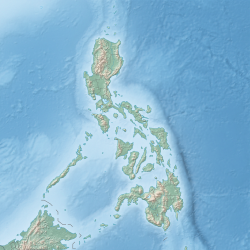Cabilao Island
 | |
| Geography | |
|---|---|
| Coordinates | 9°52′40″N 123°46′20″E / 9.8778°N 123.7722°E |
| Archipelago | Visayas |
| Area | 7.66 km2 (2.96 sq mi)[1] |
| Administration | |
Philippines | |
| Region | Central Visayas |
| Province | Bohol |
| Municipality | Loon |
| Demographics | |
| Population | 4,636 (2020 census)[2] |
| Pop. density | 610/km2 (1580/sq mi) |
Cabilao is a Philippine island in the Cebu Strait, part of Bohol Province. It is home to the only natural lake in the province: Cabilao Island Lake, also called Lake Danao or Lanao.[1][3]
The island, part of the Municipality of Loon, has five barangays (Cabacongan, Cambaquiz, Looc, Pantudlan, and Talisay), and has a total population of 4,636 people,[2] who primarily depend on fishing and agriculture, as well as tourism.[4]
Notable indigenous products are handcrafted mats and bayongs, weaved from romblon (pandanus) leaves by a cooperation of weavers using a shared service facility in Pantudlan.[5][6]
The entire island was proclaimed as a Mangrove Swamp Forest Reserve under Proclamation No. 2152 in 1981, and confirmed by the National Integrated Protected Areas System (NIPAS) Act of 1992 (Republic Act No. 7586). But since only a small area around Cabilao Island Lake actually has any mangroves worthy of being protected, House Bill No. 5108 of February 2017 removed the island's protection under the NIPAS Act.[1] Proclamation No. 1801, signed in November 1978, declared the entire island a tourist zone and marine reserve under the administration and control of the Philippine Tourism Authority (PTA).[7]
The island is accessible by outrigger canoe ferries that connect Mocpoc on the western end of Sandingan Island to the pier on the eastern side of Cabilao Island.[4] There are no cars on the island, and local transportation consists of motorcycles and a few tricycles.[8]
Attractions
[edit]
The main tourist attraction of Cabilao Island is scuba diving and snorkeling. There are several diving locations with undisturbed coral reefs, that are home to barracudas, jackfish, ghostpipe fish, dragon fish, crabs, seahorses, damsel fish, fusiliers, parrot fish, and occasionally hammerhead and white-tipped sharks. Other attractions include a few sandy beaches, and bird watching. Since bird hunting is prohibited, there are more bird species on Cabilao Island than any other place in Bohol.[4][8]
On the north-west corner of the island, known as Punta Baluarte, are a small museum, an old abandoned lighthouse and modern lighthouse.[4][8] The museum is housed in the former ruins of the Spanish-era lighthouse building with 1-metre-thick coral stone walls, that was restored in 2011.[6] Nearby are the ruins of a Spanish-era stone watchtower of which only the foundations remain.[9]
References
[edit]- ^ a b c "House Bill No., 5108" (PDF). www.congress.gov.ph. Republic of the Philippines, House of Representatives. 22 February 2017. Retrieved 7 May 2019.
- ^ a b Census of Population (2020). "Region VII (Central Visayas)". Total Population by Province, City, Municipality and Barangay. Philippine Statistics Authority. Retrieved 8 July 2021.
- ^ "A Glimpse of Loon". www.loon.gov.ph. Municipality of Loon. Retrieved 7 May 2019.
- ^ a b c d "Cabilao Island". www.bohol-philippines.com. Bohol Philippines Travel Guide. Retrieved 7 May 2019.
- ^ Rey Anthony H. Chiu (29 June 2015). "DTI hands in P446K facility for Cabilao 'bayong' project". One Visayas e-Newsletter. 5 (26). Philippine Information Agency: 4. Retrieved 9 May 2019.
- ^ a b Ferdie Marcelo (20 May 2011). "A New Light at the Edge of Cabilao". Nature Calls. Retrieved 9 May 2019.
- ^ "Proclamation No. 1801, s. 1978". gov.ph. Official Gazette of the Republic of the Philippines. 10 November 1978. Retrieved 7 May 2019.
- ^ a b c Hellingman, Jeroen (18 March 2006). "A Visit to Cabilao Island". Bohol.ph. Retrieved 7 May 2019.
- ^ René B. Javellana (1997). Fortress of empire : Spanish colonial fortifications of the Philippines, 1565-1898. Bookmark. ISBN 9715691994.
External links
[edit] Media related to Cabilao Island at Wikimedia Commons
Media related to Cabilao Island at Wikimedia Commons


